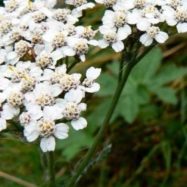A gardener’s knee-jerk reaction to pests (whether animal, insect, OR plant) is usually “kill it!” or “pull it!” — but is there a better alternative? Rather than pest eradication, let’s talk about pest management — specifically “integrated pest management” (IPM).

Yarrow attracts lady bugs
IPM is a proactive system that strives to use a variety of pest control methods with ecosystem sustainability as the main priority. Chemical controls (pesticides, whether inorganic or organic) are seen as the last resort, while preemptive biological and cultural controls take the forefront.
For example, you can control aphids (destructive plant-eaters) naturally with beneficial insects: just plant Yarrow (Achillea millefolium), which attracts parasitic wasps and lady bugs, which feed on aphids. Pull weeds by hand (with a trowel), which is easiest when the soil is wet, then spread mulch to discourage further weed growth.

Lady bugs eat aphids
IPM is the most ecologically sound system for controlling pests, and there are hundreds of strategies that can be employed before picking up that bottle of chemicals. Learn more by searching for “Integrated Pest Management” on the EPA’s website.